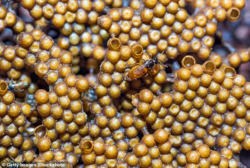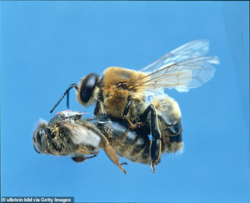
Promiscuous Queen bees more likely to be executed by their colonies
Scientists said queens which mated with more than one worker were more likely to produce infertile offspring, otherwise known as diploid males. Stingless bees are found in Brazil.
- Queen stingless bees are at risk of being executed if they mate more than once
- Execution is because they are more likely to produce infertile useless males
- Stingless bees found in tropical climates as Brazil and are related to honeybees
Stingless bees are found in tropical climates such as Brazil and are closely related to honeybees and bumblebees.
But while a queen honeybee may mate with up to 20 males, queen stingless bees are usually loyal to one male.
Scientists said queens which mated with more than one worker were more likely to produce infertile offspring, otherwise known as diploid males

Scientists said queen stingless bees (pictured) which mated with more than one worker were more likely to produce infertile offspring
The colony will then execute the queen because the offspring are defective and cannot reproduce.
And for every diploid male produced, it means there is one less worker bee in the hive.
The study, which was published in the American Naturalist, helped biologists to understand why some species mated with multiple males while other remained loyal to one, according to The Telegraph.
The University of Sussex and University of Sao Paulo compared the fate of queens in different hives in an experiment in Brazil.
Scientists found that the queen doubled her chance of being executed if she mated with two males.

While a queen honeybee may mate with up to 20 males, queen stingless bees are usually loyal to one male. Pictured: A drone bee copulating with a queen bee
Professor Ratnieks said: 'In short, it is due to the genetics of sex determination in bees and the risk of what is known as 'matched mating''.
Normal male bees are produced from an unfertilised egg and therefore only have one set of chromosomes from the mother, and therefore only one sex allele.
However if the egg is fertilised it will have two sets of chromosomes - one from the mother and one from the father.
If the two sex alleles are different, the bee is female, but if they are the same it will be a diploid male, known as 'matched mating'.